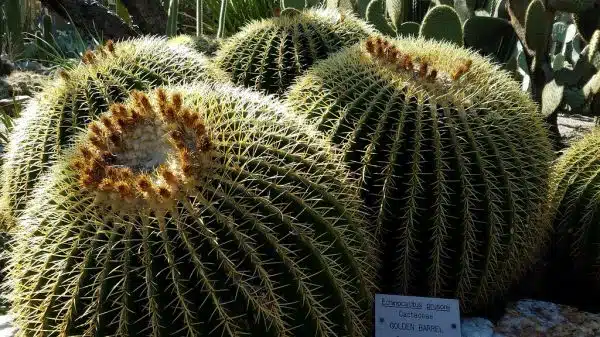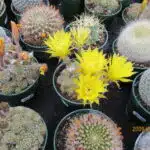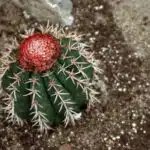Golden Barrel Cactus is a popular indoor plant, adored for its unique shape and size. This cactus with its radiant yellow spines can light up any room in which it is placed. While these plants are typically found in desert regions, they can be grown indoors – making them perfect for those who want to bring a touch of the southwest into their homes.
Growing and taking care of a Golden Barrel Cactus indoors requires certain skills and knowledge. These plants require specific conditions to thrive, such as bright light and infrequent watering. In this article, we will discuss how to grow and care for Golden Barrel Cactus indoors – from choosing the right potting soil to providing adequate lighting and temperature control. With our guidance, you can enjoy the beauty of this magnificent plant without worrying about harming it due to lack of knowledge on proper care techniques.
The Golden Barrel Cactus: An Introduction
Although the Golden Barrel Cactus is a popular indoor plant, some may question its ability to thrive in a confined space. However, with the right care and environment, this cactus can flourish as an ornamental addition to any home.
Characteristics of the Golden Barrel Cactus include a round shape with dense spines covering its surface. It is slow-growing and can reach up to three feet tall and wide at maturity. Its bright yellow coloration adds warmth to any space it inhabits, making it an attractive choice for decorators looking for a touch of desert flair.
Habitat requirements for the Golden Barrel Cactus include plenty of sunlight, well-draining soil, and minimal water. In its natural habitat of Mexico’s desert regions, it receives full sun exposure and low humidity levels. Therefore, when caring for this plant indoors, it is crucial to mimic these conditions as closely as possible to ensure its survival and thriving growth.
Transitioning into choosing the right pot for your golden barrel cactus: As important as providing specific environmental conditions is selecting an appropriate pot that will enable healthy growth without compromising root development.
Choosing The Right Pot For Your Golden Barrel Cactus
- The size of the container a golden barrel cactus is planted in directly affects the growth and health of the plant.
- The container must be able to provide proper drainage to avoid waterlogging the roots.
- For a golden barrel cactus, a pot with a diameter of 6 to 10 inches is ideal.
- The pot should also have a drainage hole at the bottom to ensure excess water can escape.
- A soil with good drainage is also essential, a succulent and cactus potting soil is ideal.
- This soil should be light and airy to ensure the roots are not waterlogged and the plant is given enough oxygen for proper growth.
Pot Size
When it comes to choosing the right pot for your golden barrel cactus, one of the most important factors to consider is pot size. The size of your pot can impact the health and growth of your cactus in several ways. Firstly, a pot that is too small can stunt the growth of your cactus and limit its root development. On the other hand, a pot that is too large can lead to overwatering and poor drainage, which can cause root rot.
To ensure optimal growth and health for your golden barrel cactus, it’s recommended that you choose a pot that is just slightly larger than the current size of your plant. This will allow room for growth without overwhelming the roots with excess soil. Additionally, make sure that your chosen pot has adequate drainage holes to prevent waterlogging and promote healthy root development.
When selecting a potting mix for your golden barrel cactus, it’s essential to choose one that is well-draining and suitable for cacti and succulents. Avoid using regular garden soil or heavy potting mixes as these can retain too much moisture, leading to root rot. Instead, opt for a mix specifically formulated for cacti and succulents or create your own by combining sand, perlite, and peat moss in equal parts. With proper care and attention to pot size and drainage, you can enjoy a thriving golden barrel cactus in your home.
Drainage
When it comes to growing a healthy and thriving golden barrel cactus, choosing the right pot is essential. In addition to considering the size of the pot, proper drainage is also crucial for the health of your plant. Without adequate drainage, excess water can accumulate in the soil, leading to root rot and other issues.
To ensure proper drainage for your golden barrel cactus, choose a pot with several drainage holes at the bottom. It’s also important to use a well-draining soil mix that allows excess water to flow out of the pot easily. Watering frequency is another factor that can impact drainage – overwatering can lead to standing water in the pot, while underwatering can cause soil to become too dry and compacted.
In addition to promoting proper drainage, using a suitable soil mix can also help maintain optimal soil acidity for your golden barrel cactus. Most cacti and succulents prefer slightly acidic soil with a pH between 6.0 and 7.5. A well-draining soil mix made specifically for cacti and succulents will typically have an appropriate pH level, but it’s still important to monitor soil acidity regularly using a pH meter or test kit. By carefully considering pot size and drainage when growing your golden barrel cactus, you can create an ideal environment for healthy growth and long-term success.
Soil Type
When it comes to growing a healthy golden barrel cactus, choosing the right pot and soil type is crucial. In addition to proper drainage, using a well-draining soil mix that meets the plant’s nutritional needs is important for its long-term success. The best soil type for golden barrel cacti should be porous, well-aerated, and rich in nutrients.
A suitable soil mix for golden barrel cacti should have an ideal pH level of between 6.0 and 7.5. Most cacti and succulents prefer slightly acidic soil, but it’s essential to monitor the pH regularly using a pH meter or testing kit. Using the best fertilizers can also help maintain optimal soil fertility for this type of cactus. Slow-release fertilizers formulated specifically for cacti and succulents are usually recommended.
Golden barrel cacti thrive in soils that are made up of a combination of organic matter, coarse sand, perlite or pumice, and peat moss or coconut coir. Adding some gravel or small rocks at the bottom layer of the pot can also improve drainage while providing additional stability to the plant’s root system. By choosing a suitable soil mix with adequate nutrients and maintaining an appropriate pH level through regular monitoring, you can ensure that your golden barrel cactus grows healthy and strong over time.
The Importance Of Proper Soil For Golden Barrel Cactus
Choosing the right pot for your golden barrel cactus is crucial in ensuring its healthy growth. However, proper soil also plays a significant role in keeping your plant thriving indoors. Using fertilizers and soil amendments can improve the quality of your soil, which is essential in providing your plant with essential nutrients.
Golden barrel cacti thrive in well-draining soil that allows water to flow freely. A mixture of cactus soil and perlite or sand can help improve drainage while preventing water from accumulating around the roots of your plant. Additionally, adding an organic matter such as compost can help retain moisture, making it more accessible to your plant’s roots.
Maintaining proper soil moisture levels is also vital for the health of your golden barrel cactus. Overwatering can cause root rot, leading to severe damage and even death of your plant. On the other hand, underwatering can cause dehydration and stunted growth. Therefore, it is essential to monitor your plant’s soil moisture levels regularly and adjust watering accordingly. In the next section, we will discuss how often you should water your golden barrel cactus and some tips on how to do it correctly.
Watering Your Golden Barrel Cactus
The watering frequency for your golden barrel cactus is an important factor that can influence its growth and survival. To determine when to water your cactus, it is essential to check the soil moisture level. The best way to do this is by sticking a finger into the soil about an inch deep. If the soil feels dry, it’s time to water your plant.
Overwatering your golden barrel cactus can lead to root rot, which can be fatal for your plant. It is crucial to ensure that the soil dries out completely before watering again. Avoid leaving standing water in the pot or saucer as it can lead to fungal growth and other problems.
Here’s a table that outlines how often you should water your golden barrel cactus depending on the season and environmental factors:
| Season | Temperature | Humidity | Watering Frequency |
|---|---|---|---|
| Spring/Summer | 70-85°F (21-29°C) | 20-40% | Once a week |
| Fall/Winter | 50-60°F (10-16°C) | 30-50% | Every 2 weeks |
Providing adequate light for indoor golden barrel cactus is crucial for its growth and overall health. Inadequate light can result in stunted growth and yellowing of leaves. In contrast, too much direct sunlight can scorch the plant’s sensitive skin. In the next section, we’ll explore how much light your plant needs and how you can provide it with optimal growing conditions.
Providing Adequate Light For Indoor Golden Barrel Cactus
One of the most important factors in successfully growing golden barrel cactus indoors is providing adequate light. While these plants can tolerate some shade, they will thrive best with bright, direct sunlight for at least several hours each day. If you don’t have access to a sunny window or live in an area with limited natural light, using grow lights can be a great solution.
When using grow lights for your golden barrel cactus, it’s important to choose the right type of bulb and fixture. Look for bulbs labeled specifically as “grow lights” or “plant lights,” as these will emit the essential spectrum of light that plants need for photosynthesis. You’ll also want to consider the distance between the plants and the lights – too close and they could become scorched or stressed, while too far away could result in weak growth or even death.
In addition to providing ample light, temperature control is another key aspect of caring for indoor golden barrel cactus. These plants prefer warm temperatures ranging from 70-85°F during the day and 50-55°F at night. Avoid placing them near cold drafts or air conditioning vents, as sudden temperature changes can cause damage. With proper lighting and temperature management, your golden barrel cactus should thrive and provide years of enjoyment in your home.
As we’ve discussed how to provide adequate lighting through grow lights or choosing a sunny location for indoor golden barrel cactus, we must not overlook the significance of appropriate temperature control. Maintaining ideal temperatures between 70-85°F during the day time and 50-55°F overnight are crucial to ensure healthy growth and blooming of these desert natives. Therefore, it’s advisable not to expose them to cold drafts or air conditioning vents that could lead to sudden fluctuations in temperature causing harm instead of prosperity.
Temperature Control For Healthy Golden Barrel Cactus
One interesting statistic to note when it comes to the optimal temperature for golden barrel cactus is that these plants are native to the hot and dry climate of Mexico. Therefore, they thrive in temperatures between 60-80°F (15-27°C). Keeping your indoor temperature within this range will ensure a healthy and happy golden barrel cactus.
However, it’s important to note that temperature fluctuations can be detrimental to the health of your cactus. Extreme changes in temperature can cause stress on the plant, leading to stunted growth or even death. Keep your golden barrel cactus away from drafty areas such as doors or windows where temperature variations may occur.
To maintain optimal temperature levels for your golden barrel cactus, consider placing it near a sunny window during the day and moving it away from any cold drafts at night. Additionally, if you live in an area with harsh winters or summers, providing extra insulation with blankets or bubble wrap around the pot can also help regulate the plant’s temperature. By taking these steps, you can ensure that your golden barrel cactus stays healthy and happy in its indoor environment.
As we’ve discussed above, maintaining optimal temperatures is crucial for keeping your golden barrel cactus healthy and thriving indoors. However, another important aspect of caring for this plant is fertilizing. In the next section, we’ll discuss how to properly fertilize your cactus for maximum growth and vitality.
Fertilizing Your Golden Barrel Cactus
When fertilizing a golden barrel cactus, one should consider the type of fertilizer being used. An all-purpose fertilizer that contains nitrogen, phosphorous and potassium is best for promoting growth. Additionally, the fertilizer should be applied in small amounts every four to six weeks during the growing season. Over-fertilizing should be avoided as this can damage the cactus.
Fertilizer Types
In the world of fertilizers, there are two main types: organic and synthetic. Organic fertilizers are derived from natural sources such as animal manure, compost, and bone meal. They release nutrients slowly over time and improve soil structure. On the other hand, synthetic fertilizers are made with chemicals and provide an immediate nutrient boost to plants. When it comes to golden barrel cacti, both types can be used but it is important to choose a fertilizer that is specifically formulated for cacti.
Golden barrel cacti do not require frequent fertilization as they are slow-growing plants that can thrive in poor soil conditions. Generally, it is recommended to fertilize them once or twice a year during their active growing season which is usually from spring to early fall. Over-fertilizing can lead to excessive growth which may cause the plant to become unstable and eventually topple over.
When deciding on a fertilizer for your golden barrel cactus, consider the type of environment in which it will be growing. If you prefer an all-natural approach, organic fertilizers may be a better option for you. However, if you want quick results and do not mind using chemicals, synthetic fertilizers can be effective as well. Regardless of your choice, always follow the instructions on the label and avoid applying too much fertilizer at one time. By choosing the right type of fertilizer and applying it appropriately, your golden barrel cactus will continue to thrive indoors for years to come.
Fertilizer Frequency
Fertilizer Frequency is a crucial aspect of caring for your golden barrel cactus. These plants are slow-growing and can thrive in poor soil conditions, so frequent fertilization is unnecessary. Fertilizing them once or twice a year during their active growing season, which typically spans from spring to early fall, is recommended. Over-fertilizing can lead to excessive growth that may cause the plant to become unstable and eventually topple over.
When it comes to organic vs synthetic fertilizers, both types can be used on golden barrel cacti. However, it is essential to choose a fertilizer specifically formulated for cacti. Organic fertilizers release nutrients slowly over time and improve soil structure, while synthetic fertilizers provide an immediate nutrient boost to plants. While both options can be effective, overuse of either type could lead to over-fertilization.
Signs of over-fertilization include yellowing leaves or leaf tips, stunted growth, and burned roots. If you notice any of these symptoms in your golden barrel cactus after fertilizing it, stop using the fertilizer immediately and flush the soil with water to remove any excess nutrients. Following proper fertilizer frequency guidelines and choosing the right type of fertilizer will help ensure that your golden barrel cactus remains healthy and thriving for years to come.
Pruning And Propagation Techniques For Golden Barrel Cactus
Propagation methods and pruning techniques are essential to maintain the health and beauty of your golden barrel cactus. These techniques will help the plant grow into a more robust and healthier specimen, enhancing its aesthetic value. There are several propagation methods to choose from, including seed sowing, stem cutting, and offset division.
Seed sowing is the most common method of propagating golden barrel cactus. The seeds should be planted in well-draining soil and kept moist until they germinate. It is essential to ensure that the soil temperature remains consistent during this period. Stem cutting is another method of propagation that involves severing a healthy stem from the parent plant and allowing it to dry for a few days before planting it in well-draining soil. Finally, offset division refers to removing offsets or small plants growing around the base of an existing plant.
Pruning techniques such as removing dead or diseased parts of the plant can prevent further damage to your golden barrel cactus. Pruning also helps control the size of your plant by removing excess growth while promoting new growth in other parts of the plant. It is best to prune during early spring when new growth starts to appear on the plant. Always use sterilized tools when pruning to avoid spreading diseases between plants.
Now that you have learned about propagation methods and pruning techniques for your golden barrel cactus, it’s time to move on to dealing with common pests and diseases that may affect your plant’s health. By taking these steps, you can ensure that your cactus thrives indoors, providing you with a stunning addition to your home decor while serving others who admire its beauty!
Dealing With Common Pests And Diseases In Golden Barrel Cactus
Anticipated objection: It can be disheartening to discover that your beautiful golden barrel cactus has been infested with pests or diseases. However, this is a common problem that many indoor gardeners face. The good news is that there are preventive measures you can take and organic solutions available to help you combat these issues.
Firstly, prevention is key when it comes to pests and diseases in golden barrel cacti. Make sure to keep the plant in a location that receives plenty of sunlight and good air circulation. This will help prevent moisture buildup which can attract pests like mealybugs and spider mites. Additionally, avoid overwatering as this can lead to root rot and other fungal infections.
If you do notice pests or diseases on your golden barrel cactus, there are several organic solutions that can help. For example, neem oil is a natural insecticide that can be used to control pests like aphids and spider mites. Diluted hydrogen peroxide can also be effective against fungal infections like powdery mildew. It’s important to follow instructions carefully when using these solutions to ensure they are applied safely and effectively.
Transition sentence: While preventing pests and diseases is important for the health of your golden barrel cactus, repotting is another crucial aspect of caring for this plant.
Repotting Your Golden Barrel Cactus
Repotting your golden barrel cactus is a crucial aspect of its overall care. It’s important to repot your plant when you notice that it has outgrown its current container or if the soil is no longer providing enough nutrients. Repotting can be done at any time of the year, but it’s best to do it during the growing season for optimal results.
When repotting your golden barrel cactus, there are a few techniques to keep in mind. First, choose a pot that is slightly larger than its current one. Next, make sure to wear gloves and use a soft, dry cloth to gently remove the plant from its old container. Be careful not to damage any roots in the process. Once you’ve removed it from the old pot, inspect the roots for any signs of damage or disease before replanting it in fresh soil.
Soil types are also essential when repotting your golden barrel cactus. The ideal soil mixture should be well-draining and contain sand, perlite or pumice to ensure good drainage and prevent root rot. Avoid using heavy soils that retain too much moisture as they can lead to root rot and other fungal infections. Use the table below as a guide for selecting suitable soil mixes based on different conditions.
| Condition | Soil Mix |
|---|---|
| Standard Mix | 1 part peat moss + 1 part perlite + 2 parts coarse sand |
| High Drainage Mix | 1 part peat moss + 2 parts perlite + 3 parts coarse sand |
| Low Nutrient Mix | 2 parts gravel + 1 part perlite + 3 parts coarse sand |
By following these repotting techniques and choosing the right soil mix, you can ensure that your golden barrel cactus will thrive and continue to grow successfully indoors. In the next section, we will discuss how to create a suitable indoor environment for your cactus.
Creating A Suitable Indoor Environment For Golden Barrel Cactus
As with any plant, creating a suitable indoor environment for a golden barrel cactus is crucial to its growth and longevity. Indoor temperature plays a significant role in the health of your cactus. These plants thrive in temperatures ranging from 60-85°F (15-29°C), so it’s important to maintain consistent temperatures within this range. Avoid placing your cactus near drafty windows or doors, which can cause temperature fluctuations.
Humidity levels are also crucial for the well-being of your golden barrel cactus. These plants prefer low humidity levels, similar to their native habitat in Mexico. Aim for humidity levels between 10-30%. If you live in a particularly humid area, consider using a dehumidifier or placing your cactus near an air conditioning unit. It’s also essential to avoid overwatering, as excess moisture can lead to rot and other fungal diseases.
Maintaining proper indoor temperature and humidity levels are essential for the health of your golden barrel cactus. Remember to keep temperatures within the recommended range and aim for low humidity levels between 10-30%. By providing your plant with an optimal environment, you’ll be setting it up for success and ensuring its longevity. In the next section, we’ll discuss some maintenance tips that will help keep your golden barrel cactus thriving.
Golden Barrel Cactus Maintenance Tips
A crucial aspect of maintaining a healthy golden barrel cactus is pest prevention. Golden barrel cacti are susceptible to mealybugs and spider mites, so it is essential to inspect them regularly for signs of infestation. These pests can damage the plant’s roots, causing stunted growth and yellowing of the leaves. To prevent infestations, avoid overwatering the cactus and ensure that its soil is well-draining. If you do notice pests on your plant, wipe them off with a damp cloth or use an insecticidal soap.
Soil preparation is another important factor in caring for your golden barrel cactus. These plants require well-draining soil that mimics their native habitat, which is typically rocky and sandy. You can create this type of soil by mixing sand, perlite, and gravel into a standard cactus potting mix. This mixture will provide excellent drainage while also allowing air to circulate around the roots. A well-prepared soil will also help prevent root rot caused by overwatering.
In addition to pest prevention and soil preparation, there are other maintenance tasks you should perform regularly to keep your golden barrel cactus healthy. These include pruning away dead or damaged growth, repotting the plant every two to three years as it outgrows its container, and providing it with adequate light exposure. With proper care and attention, your golden barrel cactus will thrive indoors for years to come.
To further enhance your knowledge about growing golden barrel cactus indoors, we have prepared a list of frequently asked questions that will guide you through any challenges that may arise during the process.
Frequently Asked Questions About Growing Golden Barrel Cactus Indoors
As the golden barrel cactus thrives in arid conditions, it is best to avoid overwatering it. This type of cactus requires infrequent watering, and it is crucial to let the soil dry out between each watering session. Overwatering can cause root rot, which may eventually lead to the death of the plant. The frequency of watering depends on various factors such as pot size, humidity levels, and temperature. Typically, a small pot requires less water than a large one.
Choosing the right pot size for your golden barrel cactus is another essential factor to consider when growing this plant indoors. The pot should be slightly larger than the root ball of your cactus so that there is enough room for growth but not too much space that retains excess moisture in the soil. A well-draining pot with drainage holes at the bottom is also necessary to prevent waterlogging.
When caring for your golden barrel cactus indoors, understanding how much water and what pot size to use can help ensure its survival. However, if you encounter any issues while growing this plant, troubleshooting common problems such as yellow or brown spots on its body or wilting can help you diagnose and fix any underlying issues promptly.
Troubleshooting Common Issues With Indoor Golden Barrel Cactus
Brown Spots: Brown spots on the golden barrel cactus can be a result of too much exposure to direct sunlight or excessive watering. Wilting: Wilting of the golden barrel cactus may be caused by an insufficient amount of light, too much heat, or an inadequate water supply. Overwatering: Overwatering of the golden barrel cactus can lead to root rot, causing the cactus to become soft and discolored. Prevention includes providing proper drainage and avoiding frequent watering of the cactus.
Brown Spots
To grow and care for golden barrel cactus indoors, it is essential to know how to troubleshoot common issues that may arise. One of the most common issues is the development of brown spots on the cactus. These spots are a sign of damage or disease and require immediate attention to prevent further harm.
Preventing brown spots on your indoor golden barrel cactus can be achieved by providing adequate sunlight, watering properly, and avoiding overfertilization. The cactus should receive at least six hours of direct sunlight per day, and watering should only occur when the soil is completely dry. Overfertilizing can cause nutrient burn, which can lead to brown spots on the cactus. Using a balanced fertilizer every two weeks during the growing season can help prevent this issue.
If brown spots have already developed on your golden barrel cactus, it is crucial to treat them promptly. You can do this by removing any affected areas with a clean, sharp knife and allowing the wound to callus over before watering again. If the spots are due to disease, you may need to apply a fungicide or seek professional help from a horticulturist. By taking preventative measures and addressing issues as soon as they arise, you can ensure that your indoor golden barrel cactus remains healthy and free of brown spots.
Wilting
Wilting is another common issue that may affect indoor golden barrel cactus. Wilting occurs when the cactus is not receiving enough water, or the soil is too dry. This can also happen when the cactus is exposed to prolonged periods of direct sunlight without adequate hydration. Preventing wilting requires regular watering and ensuring that the soil is moist but not soaked. It is essential to monitor the moisture level of the soil regularly to ensure that it does not dry out completely.
If your indoor golden barrel cactus has already started wilting, there are some steps you can take to revive it. First, move the cactus to a spot with partial shade and away from direct sunlight. Next, check the moisture level of the soil and water appropriately. Be careful not to overwater as this can lead to root rot and other issues. If the roots are damaged, repotting may be necessary to promote healthy growth.
Preventing wilting in your indoor golden barrel cactus requires consistent care and attention. Regular monitoring of moisture levels, proper watering techniques, and providing adequate shade can help prevent this issue from occurring. By taking preventative measures and addressing issues as soon as they arise, you can ensure that your indoor golden barrel cactus stays healthy and vibrant for years to come.
Overwatering
Preventing overwatering is crucial in maintaining the health and vitality of your indoor golden barrel cactus. Overwatering occurs when the soil remains too wet for an extended period, leading to root rot and other issues. Signs of overwatering to watch out for include yellowing or browning of leaves, mushy stems, and a foul odor emanating from the soil. To prevent overwatering, it is essential to let the soil dry out completely before watering again.
When dealing with an overwatered indoor golden barrel cactus, it is important to act quickly to avoid further damage. First, remove any excess water from the soil and allow it to dry out. Next, trim off any damaged or rotted roots and repot the cactus in fresh soil. Carefully monitor watering after repotting and adjust as needed.
Preventing overwatering in your indoor golden barrel cactus requires careful attention to watering habits and understanding its unique needs. By regularly checking moisture levels, allowing the soil to dry out between waterings, and providing adequate drainage, you can help ensure that your indoor golden barrel cactus thrives in its environment.
Conclusion: Growing And Caring For Golden Barrel Cactus Indoors
Once you’ve established the perfect indoor positioning for your golden barrel cactus, it’s important to maintain its health. One of the most crucial elements of caring for this type of cactus is ensuring that the soil it’s planted in is well-draining. This will prevent water from sitting and causing root rot, which can quickly kill your plant. Consider using a cactus-specific potting mix that allows excess water to drain away quickly.
Another factor in maintaining golden barrel cactus health is providing adequate light. These cacti need plenty of sunlight to thrive, so choose an area in your home that receives direct sunlight for at least 6 hours each day. If natural light isn’t possible or sufficient, consider using grow lights to mimic sunlight and keep your plant healthy.
It’s also important to avoid overwatering your golden barrel cactus. These plants are drought-tolerant and can go several weeks without water if necessary. Only water when the soil is completely dry and use a watering can with a spout to carefully apply water directly to the soil rather than over the top of the plant. By following these tips, you’ll be able to successfully grow and care for a beautiful golden barrel cactus indoors!
Frequently Asked Questions
Can Golden Barrel Cactus Survive In Low Light Conditions?
It is quite amusing to think that a cactus, which is often associated with harsh desert climates and thriving under the scorching sun, could even survive in low light conditions. However, the golden barrel cactus surprisingly has the ability to adapt and survive in such environments. While it may not thrive as well as it would in bright light conditions, this cactus can still manage to survive with proper care and alternative light sources. As a horticulturalist, it is important to note that providing an adequate amount of light for any plant is crucial for its growth and development. Therefore, when it comes to the golden barrel cactus, incorporating alternative light sources such as fluorescent bulbs or LED lights can be beneficial for its low light survival.
How Often Do I Need To Fertilize My Golden Barrel Cactus?
Fertilizer frequency is an essential aspect of the care routine for a golden barrel cactus. It is recommended to fertilize once every three to four months during the growing season, which extends from spring to early fall. However, it should be noted that over-fertilizing can cause harm to the cactus. Therefore, it is important to follow the instructions on the fertilizer package and avoid using too much. Additionally, soil nutrients play a crucial role in maintaining healthy growth for the golden barrel cactus. The soil should be well-draining and enriched with nutrients such as phosphorus, nitrogen, and potassium. Regularly testing soil pH levels can also help ensure that the necessary nutrients are present for optimal growth.
Can I Grow Golden Barrel Cactus In A Terrarium?
Golden barrel cactus, also known as Echinocactus grusonii, is a popular choice for indoor gardening enthusiasts. While these plants can thrive in regular pots, some may wonder if they can grow them in terrariums or other alternative containers. It is possible to grow golden barrel cactus in a terrarium setup with proper care and attention given to the plant’s needs. However, it’s important to note that these plants require good ventilation and minimal humidity levels to survive. Additionally, the size of the terrarium or container should be large enough to accommodate the cactus’ root system and allow for proper drainage. Horticulturalists suggest using well-draining soil mixtures and limiting watering frequency to avoid overwatering in enclosed spaces. Overall, growing golden barrel cactus in a terrarium can be a unique way to showcase their beauty but requires careful consideration of their environmental needs.
How Long Does It Take For Golden Barrel Cactus To Bloom?
The golden barrel cactus, a symbol of the desert’s resilience and beauty, is known for its stunning blooms. However, this plant can take several years to reach maturity and produce flowers. On average, it takes 10-15 years for a golden barrel cactus to bloom. The growth rate of this cactus depends on various factors such as light, temperature, and soil quality. For optimal growth conditions indoors, the golden barrel cactus requires bright but indirect sunlight and well-draining soil. Overwatering should be avoided as it can lead to root rot. As a horticulturalist, it is essential to understand that patience is key when caring for a golden barrel cactus as it takes time to reach its full potential and reward you with its magnificent flowers.
Is It Safe For Pets To Be Around Golden Barrel Cactus?
Pet safety is a crucial consideration when growing indoor plants. For pet owners who are interested in incorporating the golden barrel cactus into their home, it is essential to know that this plant can be toxic to pets. The plant contains oxalates, which can cause gastrointestinal irritation and other health problems when ingested by dogs or cats. As a horticulturalist, I recommend taking precautions to ensure pet safety when growing this plant indoors. Pet owners should keep the golden barrel cactus out of reach of their pets and avoid exposing them to any broken parts of the plant. In addition, if a pet does ingest part of the cactus, they should be taken immediately to a veterinarian for treatment. By being aware of the potential toxicity of this plant and taking proper precautions, pet owners can safely enjoy the beauty and unique features of the golden barrel cactus in their indoor environment.
Conclusion
Golden Barrel Cactus is a hardy plant that can thrive in indoor conditions, even with minimal care. It is important to note that this plant requires ample sunlight and well-draining soil to grow properly. While it is possible to fertilize the cactus occasionally, it is not necessary for its survival. Growing Golden Barrel Cactus in a terrarium is not recommended due to its size and growth rate.
It takes several years for Golden Barrel Cactus to bloom, typically around five years or more. Once mature, the plant produces yellow flowers that bloom in the summer months. It is important to keep pets away from Golden Barrel Cactus as it can be toxic if ingested.
According to a recent study, indoor plants have been shown to improve air quality and reduce stress levels. As such, keeping Golden Barrel Cactus indoors not only adds aesthetic value but also promotes healthy living environments. With proper care and attention, this cactus can thrive in indoor settings and bring joy and beauty into any space.
Image Credits
- “Golden Barrel Cactus closeup” by yumievriwan (featured)





























